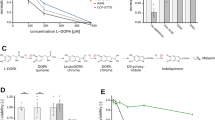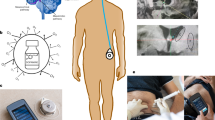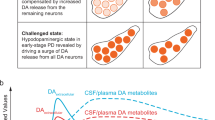Abstract
THE exact neurophysiological role of dopamine is still unclear, but it has been implicated in the functioning of the extra-pyramidal motor system (EPS)1,2. Experiments on animals and humans, however, indicate that the smooth functioning of the EPS depends on a fine balance between several biogenic amines3–5. Nevertheless, deficiencies of brain dopamine resulting from degeneration of the substantia nigra seem to be associated with the extrapyramidal symptoms of Parkinson's disease1–6. In accordance with these observations, attempts have been made to raise brain dopamine levels in patients suffering from Parkinsonism. Dopamine itself cannot be used, for it is incapable of crossing the blood-brain barrier, and therefore dopamine precursors, in particular L-3,4-dihydroxyphenylalanine (L-dopa), have been used7–10. Although such treatment apparently relieves the symptoms of hypokinesia, rigidity and posture, tremor is little affected and the necessity for large daily dosage and the side-effects of nausea and hypotension remain as serious drawbacks to the therapeutic use of L-dopa. Stock11 has recently suggested that 2-amino-4-hydroxy-6,7-dimethyltetrahydropteridine may be a potential anti-parkinsonism agent since this tyrosine hydroxylase cofactor may be deficient in patients suffering from Parkinsonism12.
This is a preview of subscription content, access via your institution
Access options
Subscribe to this journal
Receive 51 print issues and online access
$199.00 per year
only $3.90 per issue
Buy this article
- Purchase on SpringerLink
- Instant access to full article PDF
Prices may be subject to local taxes which are calculated during checkout
Similar content being viewed by others
References
Hornykiewicz, O., Pharmacol. Rev., 18, 925 (1966).
Hornykiewicz, O., Pharmako-psychiat. Neuro-psyehopharmakol., 1, 6 (1968).
Friedman, A. H., and Everett, G. M., Adv. Pharmacol., 3, 83 (1964).
Curzon, G., Intern. Rev. Neurobiol., 10, 323 (1968).
Ernst, A. M., Acta Physiol. Pharmacol. Neerl., 15, 141 (1969).
Barbeau, A., Rev. Canad. Biol., 26, 55 (1967).
Calne, D. B., Stern, G. M., Laurence, D. R., Sharkey, J., and Armitage, P., Lancet, i, 744 (1969).
Calne, D. B., Stem, G. M., Spiers, A. S. D., Laurence, D. R., and Armitage, P., Lancet, ii, 973 (1969).
Cotzias, G. C., Papavasiliou, P. S., and Gellne, R., New Engl. J. Med., 280, 337 (1969).
Godwin-Austen, E. B., Tomlinson, E. B., Frears, C. C., and Kok, H. W. L., Lancet, ii, 976 (1969).
Stock, R., J. Amer. Med. Assoc., 210, 1594 (1969).
Kuehl, F. A., Vandenheuvel, W. J. A., and Ormond, E. E., Nature, 217, 136 (1968).
Daly, J. W., Creveling, C. R., and Witkop, B. J., Med. Chem., 9, 273 (1966).
Creveling, C. R., Daly, J. W., Tokuyama, T., and Witkop, B., Experientia, 25, 26 (1969).
Brooks, C. J. W., and Horning, E. C., Anal. Chem., 36, 1540 (1960).
Horning, M. G., Moss, A. M., and Horning, E. C., Biochim. Biophys. Acta, 148, 597 (1967).
Author information
Authors and Affiliations
Rights and permissions
About this article
Cite this article
PINDER, R. Possible Dopamine Derivatives capable of Crossing the Blood-Brain Barrier in relation to Parkinsonism. Nature 228, 358 (1970). https://doi.org/10.1038/228358a0
Received:
Issue date:
DOI: https://doi.org/10.1038/228358a0
This article is cited by
-
Respiratory pattern and phrenic and hypoglossal nerve activity during normoxia and hypoxia in 6-OHDA-induced bilateral model of Parkinson’s disease
The Journal of Physiological Sciences (2020)
-
Gut bacterial tyrosine decarboxylases restrict levels of levodopa in the treatment of Parkinson’s disease
Nature Communications (2019)



